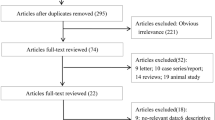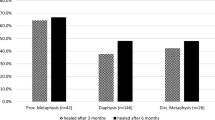Abstract
Background
This retrospective study investigated the clinical efficacy of individual extracorporeal shockwave treatment (IESWT) for early stage osteonecrosis of the femoral head (ONFH).
Material and methods
The study included 56 patients (89 hips) with 28 patients (46 hips) in the IESWT group and 28 patients (43 hips) in the conventional ESWT (CESWT) group. The ONFH was caused by the use of steroids, trauma and alcohol consumption. The IESWT focal point was from the front of the femoral head and the exposed necrotic tissue in 3D environment was guided by simulation software. The CESWT focal point was the side of the femoral head and guided by MRI and X‑ray imaging. The evaluation standards included VAS score, Harris hip score (HHS), necrosis volume and healing rate.
Results
For the healing rate the results were 66.67% were improved, 21.43% unimproved and 11.90% aggravated in the CESWT group and 77.78% improved, 17.78% unimproved and 4.45% aggravated in the IESWT group. Statistically significant differences were observed in the healing rate between the two groups (P < 0.05). This retrospective study demonstrated that the healing rate for IEWST was higher than for CEWST. There were no statistically significant differences in the VAS score and the HHS between the two groups (P > 0.05). The effects of pain relief and functional recovery were not obvious and according to our clinical experience this may be due to a short clinical observation time where a longer time might result in better clinical results. Statistically significant differences were observed in the necrosis volume after 18 months between the 2 groups (P < 0.05) and implied that IESWT can significantly reduce the volume of necrosis. The volume after 18 months in the IESWT group was significantly improved compared with baseline (P < 0.05).
Conclusion
The use of IESWT can significantly reduce the necrosis volume. No complications were found.
Zusammenfassung
Hintergrund
Diese retrospektive Studie untersuchte die klinische Wirksamkeit der individuellen extrakorporalen Stoßwellentherapie (IESWT) im Frühstadium einer Osteonekrose des Femurkopfes (ONFH).
Material und Methoden
Die Studie schloss 56 Patienten (89 Hüften) ein, davon waren 28 Patienten (46 Hüften) in der IESWT-Gruppe und 28 Patienten (43 Hüften) in der konventionellen ESWT- bzw. CESWT-Gruppe. Die ONFH wurde durch Steroidanwendung, Traumata und Alkoholkonsum verursacht. Der Fokus der IESWT lag auf der Vorderseite des Femurkopfes, und das exponierte nekrotische Gewebe wurde in 3‑D-Umgebung mittels einer Stimulationssoftware geführt. Der Fokus der CESWT lag auf der Seite des Femurkopfes und wurde mittels MRT und Röngten geführt. Die Evaluationsstandards umfassten den VAS-Score (visuelle Analogskala), den Harris-Hip-Score (HHS), das Nekrosevolumen und die Heilungsrate.
Ergebnisse
In der CESWT-Gruppe zeigten die Ergebnisse für die Heilungsrate in 66,67 % der Fälle eine Verbesserung, in 21,43 % keine Verbesserung und in 11,90 % der Fälle eine Verschlechterung. In der IESWT-Gruppe zeigte sich bei 77,78 % der Patienten eine Verbesserung, bei 17,78 % keine Verbesserung, und bei 4,45 % der Patienten eine Verschlechterung. Bezüglich der Heilungsrate wurden statistisch signifikante Unterschiede zwischen den beiden Gruppen festgestellt (p < 0,05). Diese retrospektive Studie zeigte, dass die Heilungsrate bei IEWST höher war als bei CEWST. Es gab keine statistisch signifikanten Unterschiede im VAS-Score und HHS zwischen den beiden Gruppen (p > 0,05). Auswirkungen auf Schmerzreduktion und funktionelle Besserung waren nicht ersichtlich. Nach der klinischen Erfahrung der Autoren könnte dies an der kurzen klinischen Beobachtungszeit liegen; eine längere Beobachtungszeit könnte möglicherweise zu besseren klinischen Ergebnissen führen. Statistisch signifikante Unterschiede bezüglich des Nekrosevolumens wurden nach 18 Monaten zwischen den beiden Gruppen festgestellt (p < 0,05) und zeigten, dass die IESWT das Nekrosevolumen signifikant reduzieren kann. Das Volumen in der IESWT-Gruppe nach 18 Monaten zeigte eine signifikante Verbesserung im Vergleich zum Ausgangswert (p < 0,05).
Schlussfolgerung
Die Anwendung der IESWT kann das Nekrosevolumen signifikant reduzieren. Komplikationen wurden keine festgestellt.






Similar content being viewed by others
Abbreviations
- ARCO:
-
Association Research Circulation Osseous
- CESWT:
-
Conventional extracorporeal shockwave treatment
- HHS:
-
Harris hip score
- IESWT:
-
Individual extracorporeal shockwave treatment
- MRI:
-
Magnetic resonance imaging
- ONFH:
-
Osteonecrosis of the femoral head
- VAS:
-
Visual analogue scale
References
Sun W, Li Z, Shi Z et al (2014) Relationship between post-SARS osteonecrosis and PAI-1 4G/5G gene polymorphisms. Eur J Orthop Surg Traumatol 24(4):525–529
Lee MS, Hsieh PH, Shih CH et al (2010) Non-traumatic osteonecrosis of the femoral head—from clinical to bench. Chang Keng I Hsueh 33(4):351–360
Kim SY, Kim YG, Kim PT et al (2005) Vascularized compared with nonvascularized fibular grafts for large osteonecrotic lesions of the femoral head. J Bone Joint Surg Am 87(9):2012–2018
Fuqiang Gao, Sun W, Zirong L et al (2015) High-energy extracorporeal shockwave for early stage osteonecrosis of the femoral head: a single-center case series. Evid Based Complement Alternat Med:468090. https://doi.org/10.1155/2015/468090
Ma HZ, Zeng BF, Li XL (2007) Upregulation of VEGF in subchondral bone of necrotic femoral heads in rabbits with use of extracorporeal shockwaves. Calcif Tissue Int 81(2):124–131
Zhencai Shi, Rongzi LWS et al (2006) Computerized MR imaging of femoral head necrosis volume measurement and preliminary mechanical tests. Chin J Radiol (03):288–292. https://doi.org/10.3760/j.issn:1005-1201.2006.03.017
Sen RK (2009) Management of avascular necrosis of femoral head at pre-collapse stage. Indian J Orthop 43:6–16
Lee MS, Hsieh PH, Shih CH et al (2010) Non-traumatic osteonecrosis of the femoral head—from clinical to bench. Chang Keng I Hsueh 33:351–360
van der Jagt D, Mokete L, Pietrzak J et al (2015) Osteonecrosis of the femoral head: evaluation and treatment. J Am Acad Orthop Surg 23:69–70
Chen J‑M, Hsu S‑L, Wong T et al (2009) Functional outcomes of bilateral hip necrosis: total hip arthroplasty versus extracorporeal shockwave. Arch Orthop Trauma Surg 129(6):837–841
Wang C‑J, Wang F‑S, Ko J‑Y et al (2008) Extracorporeal shock-wave therapy shows regeneration in hip necrosis. Rheumatology 47:542–546
Kumar Tripathy S, Goyal T, Kumar Sen R et al (2015) Management of femoral head osteonecrosis: Current concepts. Indian J Orthop 49(1):28–45
Wang C‑J, Wang F‑S, Huang C‑C et al (2005) Treatment for osteonecrosis of the femoral head: comparison of extracorporeal shockwaves with core decompression and bone-grafting. J Bone Joint Surg Am 87:2380–2387
Lin C, Wang CJ, Yang KD et al (2006) Extracorporeal shockwave treatment of osteonecrosis of the femoral head in systemic lupus erythematosis. J Arthroplasty 21(6):911–915
Kim S‑Y, Kim Y‑G, Kim P‑T et al (2005) Vascularized compared with nonvascularized fibular grafts for large osteonecrotic lesions of the femoral head. J Bone Joint Surg Am 87(9):2012–2018
Kang S, Gao F, Han J et al (2018) Extracorporeal shockwave treatment can normalize painful bone marrow edema in knee osteoarthritis: a comparative historical cohort study. Medicine (Baltimore) 97(5):e9796
Zhang Q, Liu L, Sun W et al (2017) Extracorporeal shockwave therapy in osteonecrosis of femoral head. Medicine 96(4):e5897
Wang CJ, Wang FS, Yang KD et al (2008) Treatment of osteonecrosis of the hip: comparison of extracorporeal shockwave with shockwave and alendronate. Arch Orthop Trauma Surg 128(9):901–908
Lee JY, Kwon JW, Park JS et al (2015) Osteonecrosis of femoral head treated with extracorporeal shockwave therapy: analysis of short-term clinical outcomes of treatment with radiologic staging. Hip Pelvis 27:250–257
Vulpiani MC, Vetrano M, Trischitta D et al (2012) Extracorporeal shockwave therapy in early osteonecrosis of the femoral head: prospective clinical study with long-term follow-up. Arch Orthop Trauma Surg 132:499–508
Author information
Authors and Affiliations
Corresponding author
Ethics declarations
Conflict of interest
H. Ding, S. Wang, H. Feng, Y. YXu. jun, D. **u na and G. **ng declare that they have no competing interests.
All procedures reported in this article were in accordance with the ethical standards of the institutional and/or national research committee and with the 1964 Helsinki declaration and its later amendments or comparable ethical standards. This article does not contain any studies with human participants or animals performed by any of the authors.
Additional information
The authors Hao Ding and Shui Wang contributed equally to the manuscript.
Rights and permissions
About this article
Cite this article
Ding, H., Wang, S., Feng, H. et al. Clinical efficacy of individual extracorporeal shockwave treatment. Orthopäde 48, 610–617 (2019). https://doi.org/10.1007/s00132-018-03682-6
Published:
Issue Date:
DOI: https://doi.org/10.1007/s00132-018-03682-6




